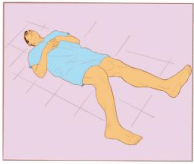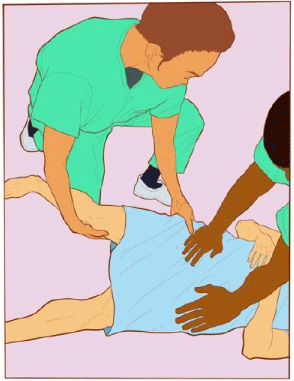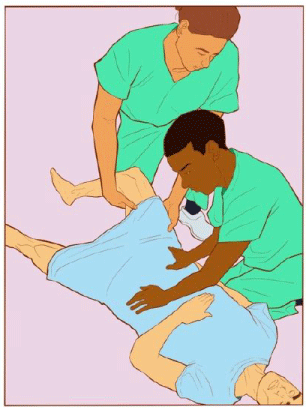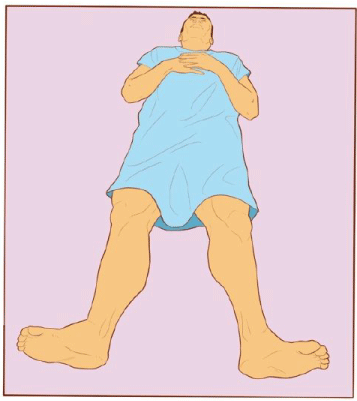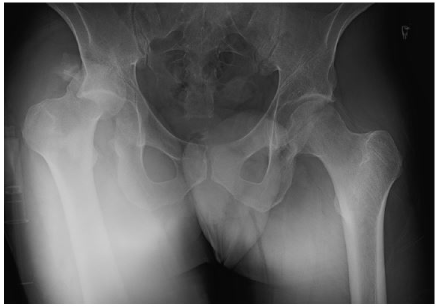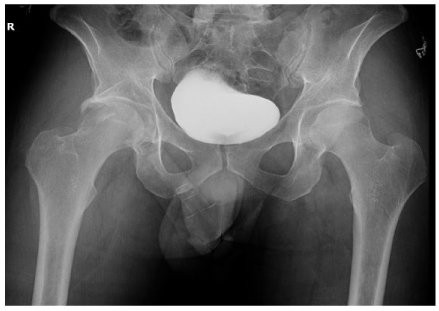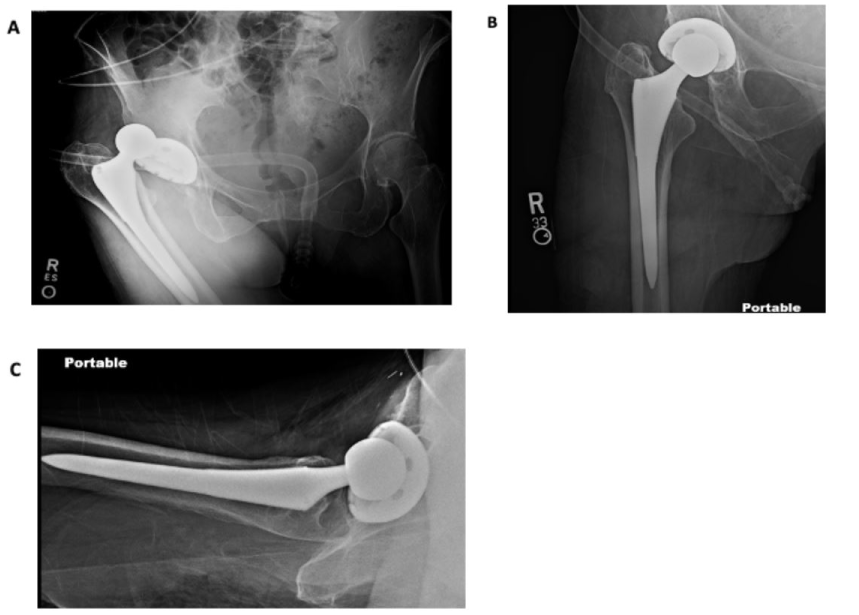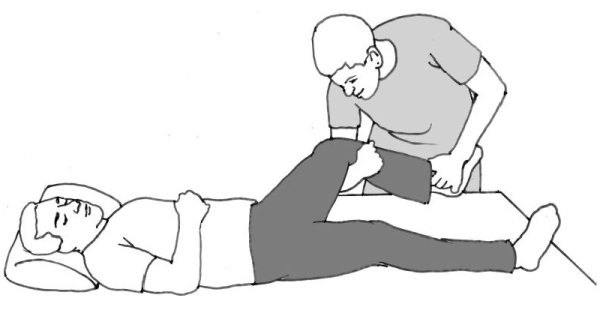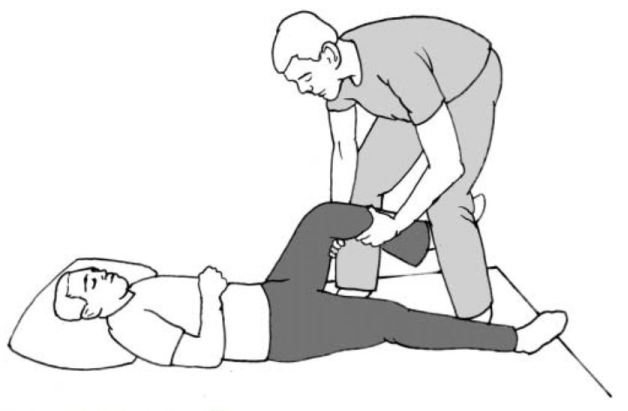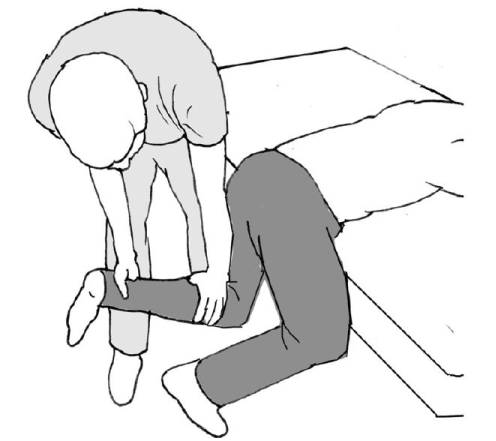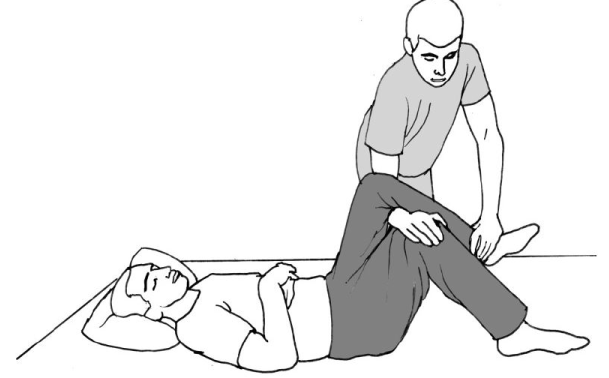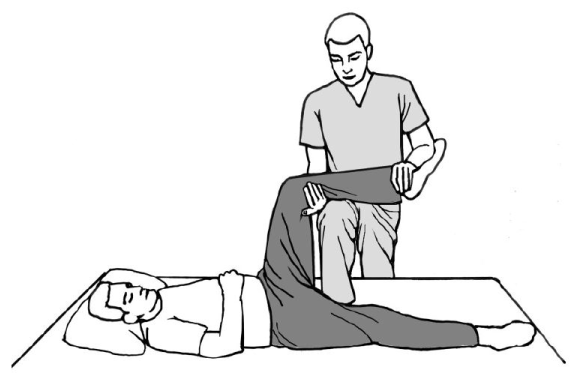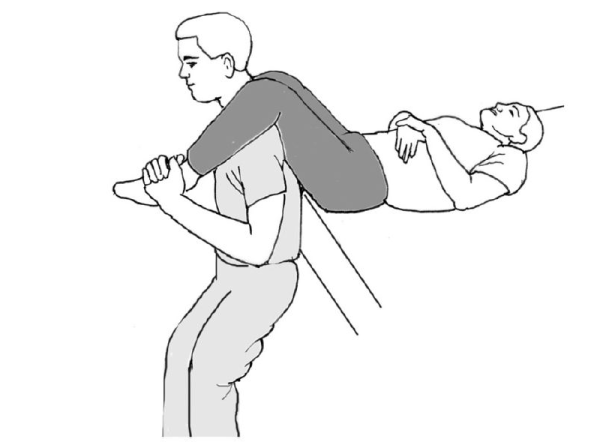JJ Maneuver: A Novel Single Operator Dependent Technique for Posterior Hip Reduction
Abstract
Introduction: Hip dislocations can occur through various mechanisms. Although native hip dislocations are uncommon, increasing rates of total hip arthroplasty has translated to prosthetic hip dislocations being encountered more frequently, especially after revision surgery. Emergency room physicians employ a myriad of techniques to reduce these dislocations with success rates ranging from 60-92% prior to subsequent surgical reduction in the operating room. Given the wide range of success offered by existing maneuvers, we propose a novel method to safely reduce any type of posterior hip dislocation while mitigating excessive strain to the provider and patient.
Technique: The JJ maneuver is unique in that there are two points of traction: (1) through the greater trochanter or femoral head proximally, and (2) at the flexed knee. This allows the ability to not only pull the limb out to length, but also control rotation. Another benefit to this technique is that it can be performed without an assistant providing pelvic stability/resistance.
Expected Outcomes: Successful hip reductions for any posterior dislocation within 1-2 attempts under conscious sedation
Discussions & Conclusions: We were able to show a reduction rate of 100% using our maneuver. All patients required conscious sedation of the emergency departments (ED) choosing. All but 1 required pelvic stability from an assisting provider for successful reduction. In conclusion, while there are many techniques utilized to reduce hip dislocations in the ED, this may soon become the primarily employed maneuver given its technical ease, low physical demand, and optional need for assistance with pelvic stabilization.
Keywords
Dislocation, Hip, Reduction, Maneuver, JJ
Introduction
The hip joint is held together by multiple ligaments that provide remarkable stability. Roughly 400 newtons of force can be tolerated by the hip ligaments before dislocation of the hip joint occurs [1]; posterior dislocations account for over 90% of all hip dislocations [2]. Native hip dislocations, while rare often occur after motor vehicle collisions with ~ 70% associated with a pelvic/acetabular fracture [2]. Prosthetic hips more commonly dislocate, especially if they have been revised. None the less, given the magnitude of forces involved with this injury, reduction of the hip joint is often challenging. Many physicians recommend 3 attempts at closed reduction before considering an intervention in the operating room (OR) [3].
Over a dozen techniques have been described for reduction of a hip dislocation. The variable responsiveness of patients to the different techniques necessitated the development of multiple maneuvers to reduce the rate of hip dislocations requiring interventions in the OR. The more commonly used methods are the Allis and Captain Morgan technique. These procedures offer variable efficacy ranging from 60-92% depending on the study [3]. As with many maneuvers, they have their limitations; the Allis technique puts the provider at risk of suffering a fall and lower back injury while the Captain Morgan technique can be more difficult to perform on those with longer legs [3]. Given the complications associated with delayed hip dislocation and the limitations of the techniques available to providers, we propose a new methodology to add to the repertoire of maneuvers physicians can use on those with a posterior hip dislocation. We believe the JJ maneuver lowers strain on the provider, without compromising effectiveness when reducing the hip.
Methods
For this technique, the patient requires conscious sedation for muscle relaxation. Our preference was a mix of ketamine and propofol. The patient is placed in the supine position with the affected leg facing upward (Figure 1). One hand is placed at the greater trochanter and the other hand is placed in the popliteal fossa (Figure 2). Axial traction is applied through the greater trochanter (or femoral head if palpable) and knee while internally rotating the affected extremity to bring the femoral head around the acetabulum posteriorly (Figure 2). In performing this movement, the deformity is exaggerated which brings the femoral head within proximity of the acetabulum. Then, traction is released, and the affected extremity is externally rotated to restore anatomic position of the hip joint (Figure 3 and Figure 4). Although the procedure can be performed by one person, an assistant can place their hand at the anterior superior iliac spines bilaterally to assist with pelvic stability (Figure 2 and Figure 3).
Results
In the setting of acute posterior hip dislocation (with or without fracture; native or prosthetic) our proposed method had a 100% success rate (6/6). Each patient had been reduced within 4 hours of arrival. No second attempts were needed. No complications were observed (Table 1). Two of the patients enrolled in the study are described: One with a native hip (38-year-old male) and the other with a prosthetic (81-year-old female). The 38-year-old male presented with a posterior wall fracture - hip dislocation following a motor vehicle accident (Figure 5); he had no other concomitant injuries and was successfully reduced on the first attempt using the JJ maneuver (Figure 6). The other patient was an 81-year-old female with a history of a total hip arthroplasty that suffered an atraumatic hip dislocation (Figure 7A). The patient was successfully reduced with our technique and had no complications from the procedure (Figure 7B and Figure 7C).
Discussion & Limitations
Some of the benefits of our method compared to others are the use of fewer practitioners (Ideally 2 for safety, though it can be performed without assistance), using two points of traction with proximal control of rotation to enable greater control of the hip joint, less energy expenditure for the provider, and fewer failed reduction attempts. The down sides to this technique are that depending on the size of practitioner's hand, the use of the arm may need to be used to assist in rotation, and body habitus may obstruct the ability to grasp femur proximally. Although we have demonstrated successful hip reduction in our cohort of patients, it is a low powered study, and more research is needed to test the efficacy of our technique in a broader clinical setting.
Hip Reduction Techniques Overview
The techniques mentioned in this paper are a collection of maneuvers that have been developed over the years from physicians of different specialties. Some of the more commonly used maneuvers within orthopaedic surgery include the Bigelow maneuver, the Allis maneuver, and the Stimson gravity technique [4,5]. The other techniques outlined may be unfamiliar to the orthopaedic community due to their origin and use in other fields like emergency medicine. Nonetheless, all the maneuvers outlined have been shown to be effective in reducing hip dislocations.
Bigelow Maneuver
This is the oldest maneuver that continues to be used for hip reductions. It was first described in 1870 [6,7]. For this technique, the affected extremity is flexed to 90° at the hip and knee [6]. The hip starts adducted, and internally rotated; the provider applies traction at the hip joint through the femur while abduction, externally rotating and extending the injured extremity. This technique has fallen out of favor over time by some due to high rates of femoral neck fractures compared to other maneuvers [3] (Figure 8).
Allis Maneuver
This technique was first described in 1895 and similar to the Bigelow maneuver [8]. For this maneuver the affected extremity is flexed to 90° at the hip and knee while the provider applies traction toward the ceiling until the hip is reduced [8]. The way the maneuver was originally described, the provider stands on the bed to perform the technique. A modified version of this technique was developed to reduce the risk of back injury to providers where the provider squats over the affected extremity, places their forearm under the knee of the affected extremity and rests their elbow on their knee; the provider then leans back while keeping the patient's leg close to their chest. Multiple studies have been published studying the efficacy of the Allis maneuver. In a study on those with a Pipkin I/II fracture, 67.3% of those analyzed retrospectively and 69.4% of those prospectively studied were successfully reduced using the Allis technique [8]. Of those that were unsuccessfully reduced with the traditional Allis maneuver, 97.2% had a successful reduction using the Modified Allis technique [8]. In a different study on patients with prosthetic hip dislocations, 62% were successfully reduced with the Allis maneuver [9]. Subgroups were analyzed based on the degree of dislocation from contact of the femoral head with the acetabulum, and those who presented at different time points following injury (Figure 9).
Those with over 50% contact between the femoral head and the acetabulum had a reduction rate of 82%, those with less than 50% contact had a reduction rate of 54%, while those with no contact between the femoral head and the acetabulum were reduced at 69 percent [9]. Those that presented within 4 hours of injury, between 4-8 hours of injury and over 8 hours of injury were reduced at 65%, 57%, and 25%, respectively [9]. Another study found 60% of hip reductions were successful when using the Allis or the modified Allis technique [10]. Of those that were unsuccessful, 67% had a Type I fracture and of those that were successful, only 20% had a Type I fracture [10]. This maneuver requires an assistant to keep the pelvis grounded.
Stimson Gravity
This technique heralds from 1883 when Lewis Stimson first described the maneuver. The patient is placed prone with the affected extremity hanging past the bed. The hip and knee are flexed to 90°. Then, the provider applies a downward force on the leg while the other arm internally and externally rotates the affected extremity while maintaining the hip adducted until the hip is reduced [11]. In the original report, Stimson reported all 3 of his patients having a successful hip reduction [11]. Although well established and more ergonomic to perform, this technique requires multiple providers, and the patient has a risk of falling off the bed. Unless the patient can use their upper extremities for stabilization, an assistant is needed to provide counter traction (Figure 10).
Whistler Maneuver
The Whistler technique has also been described by some as the Tulsa and the Rochester maneuver. For this technique, the patient flexes at the knee and the hip [3]. The provider positions their arm under the affected knee with the palm resting on the knee of the unaffected extremity [3]. The provider applies downward traction on the ankle while internally and externally rotating the hip [3]. In a study comparing the success rate of this maneuver to the Rocket Launcher technique, 60% of those were successfully reduced [12]. In the original study where this technique was described, 73.3% of patients were successfully reduced using this maneuver [10]. Of those that were unsuccessfully reduced, 75% were successful using the Allis maneuver [10]. Conversely, 1 of the 4 patients where the Allis technique was unsuccessful had their hip reduced using the Whistler maneuver [10]. This technique is beneficial because it requires only 1 provider to perform, though the upward force generated is less than other maneuvers given the use of the upper versus lower body. Like the Allis maneuver, an assistant is needed to stabilize the pelvis in almost all scenarios (Figure 11).
Captain Morgan Technique
This maneuver was described in 2011 as a variation of the Lefkowitz technique [13]. Here the provider places their flexed knee under the popliteal fossa of the affected extremity [14]. Then, they plantarflex at the ankle to elevate the leg until the hip is reduced [14]. In the original paper, the authors described a 92% success rate with 62% of their patients having a prosthetic hip [14]. The singular failure was an elderly patient with an anterior dislocation and an intraarticular fracture fragment that necessitated an open reduction and internal fixation [14]. There have also been discussions regarding the potential risk of damaging structures within the knee or causing tibial fractures in those with metastatic burden or osteoporosis [13]. Again, an assistant is needed to provide pelvic stabilization (Figure 12).
Rocket Launcher
The Rocket Launcher technique is a variant of the piggy back maneuver. The patient is placed supine with the affected leg flexed at the hip and the knee [12]. The provider sits near the edge of the bed and drapes the patient's knee over their shoulder [12]. The provider stands while applying external rotation and abduction at the hip joint [12]. In the study where this maneuver was originally described, all patients had a prosthetic hip and 5 of the 6 were successfully reduced with this technique [12]. The singular failure was a hemi-arthroscopy patient that failed multiple closed reduction techniques and required open reduction [12]. This technique only requires a singular provider, however there is a risk of ligamentous injury when performing this maneuver as the forces are transmitted through the knee. An assistant is required to provide counter traction (Figure 13).
Others
Although there are more hip reduction maneuvers disposable to physicians, many are often not practiced. Some of the more infrequently utilized techniques include the East Baltimore, flexion-adduction, foot fulcrum, Howard, lateral traction, and the Skoff maneuver [5,15-19]. The Skoff technique is similar to the one we describe, though it requires lateral positioning, different mechanics and there is little data in the literature supporting its efficacy. Of note, when practicing many of the maneuvers for hip reduction, it can be helpful to have bedsheets available to provide countertraction or hip abduction to facilitate performing the technique.
Is Hip Reduction Success Operator Dependent?
A study published in 2005 sought to identify the success rate of hip reductions by emergency medicine (EM) physicians. The study found that hip reductions performed by an EM physician had a 91% success rate [20]. Similarly, reductions performed by an orthopedic surgeon alone or reductions performed by an EM physician and an orthopedic surgeon had a 90% success rate [20]. Of all the patients studied, 9% failed closed reduction in the emergency department entirely [20]. They were subsequently taken to the operative room for open reduction. These results suggest orthopedic surgeons and EM physicians are similarly able to successfully reduce hip dislocations and does not appear to be influenced by the operator if proper technique is employed.
Hip Dislocation and Avascular Necrosis
The anatomic arrangement of the femoral circumflex arteries makes them vulnerable to injury following hip dislocation making avascular necrosis of the femoral head a common complication when reduction is delayed. Studies have shown that those with an injury to reduction time of less than 6 hours had a rate of avascular necrosis at 4.8% while those with hip reductions longer than that experience avascular necrosis at 52.9 percent [21]. Though time to reduction affects the incidence of avascular necrosis, concomitant injuries have been shown to play a role as well. Those with Steward and Milford Grade III and IV injury experienced nearly a 50% rate of avascular necrosis compared to their less severe I and II grade counterparts [21]. Of note, those with comminuted blast fractures of the acetabulum and femoral neck have the highest incidence of avascular necrosis [21].
Conclusion
Although the JJ maneuver has demonstrated efficacious in reducing posterior hip dislocations, the techniques used by physician is often driven by what they are most comfortable performing and tailored to the needs of the patient. We present a new maneuver that could decrease rates of failure, provider and patient injury, and need for additional assistance. Our technique affords physicians a new maneuver that can be utilized as the primary or secondary method for reducing posterior hip dislocations. However, additional prospective research is needed to best assess the validity our findings.
Acknowledgements
The authors would like to thank Lisandra Ochoa for her outstanding illustrations.
Conflicts of Interest
None.
References
- Han XG, Tian W (2019) Artificial intelligence in orthopedic surgery: Current state and future perspective. Chin Med J (Engl) 132: 2521-2523.
- Dawson Amoah K, Raszewski J, Duplantier N, et al. (2018) Dislocation of the hip: A review of types, causes, and treatment. Ochsner J 18: 242-252.
- Gottlieb M (2018) Hip dislocations in the emergency department: A review of reduction techniques. J Emerg Med 54: 339-347.
- Foulk DM, Mullis BH (2010) Hip dislocation: Evaluation and management. J Am Acad Orthop Surg 18: 199-209.
- Nordt WE (1999) Maneuvers for reducing dislocated hips a new technique and a literature review. Clin Orthop Relat Res 360: 260-264.
- Bigelow HJ (1870) Luxations of the hip-joint. Bost Med Surg J 82: 65-67.
- Bigelow H (1878) On dislocation of the hip. Lancet 111: 860-862.
- Ma L, Wu H, Hou Z, et al. (2014) Value of modified Allis technique in closed reduction of posteriorly dislocated hip with Pipkin I / n fracture. Natl Med J China 94: 533-535.
- Frymann SJ, Cumberbatch GLA, Stearman ASL (2005) Reduction of dislocated hip prosthesis in the emergency department using conscious sedation: A prospective study. Emerg Med J 22: 807-809.
- Walden PD, Hamer JR (1999) Whistler technique used to reduce traumatic dislocation of the hip in the emergency department setting. J Emerg Med 17: 441-444.
- Stimson LA, Peltier LF (1988) Five cases of dislocation of the hip. Clin Orthop Relat Res 231: 3-6.
- Dan M, Phillips A, Simonian M, et al. (2015) Rocket launcher: A novel reduction technique for posterior hip dislocations and review of current literature. Emerg Med Australas 27: 192-195.
- Lefkowitz M (1993) A new method for reduction of hip dislocations. Orthop Rev 22: 253-256.
- Hendey GW, Avila A (2011) The captain morgan technique for the reduction of the dislocated hip. Ann Emerg Med 58: 536-540.
- Schafer SJ (1998) The east baltimore lift: A simple and effective method for reduction of posterior hip dislocations. J Orthop Trauma 13: 56-57.
- Bassi JL, Ahuja SC, Singh H (1992) A flexion adduction method for the reduction of posterior dislocation of the hip. J Bone Jt Surg Ser B 74:157-158.
- Yin TC, Wang JW, Lao ML, et al. (2010) A simple technique for reducing posterior hip dislocation: The foot-fulcrum manoeuvre. Injury 41: 665-667.
- Howard CB (1992) A gentle method of reducing traumatic dislocation of the hip. Injury 23: 481-482.
- Skoff HD (1986) Posterior hip dislocation, a new technique for reduction. Orthop Rev 15: 405-409.
- Germann CA, Geyer DA, Perron AD (2005) Closed reduction of prosthetic hip dislocation by emergency physicians. Am J Emerg Med 23: 800-805.
- Hougaard K, Thomsen PB (1986) Traumatic posterior dislocation of the hip -Prognostic factors influencing the incidence of avascular necrosis of the femoral head. Arch Orthop Trauma Surg 106: 32-35.
- Waddell BS, Mohamed S, Glomset JT, et al. (2016) A detailed review of hip reduction maneuvers: A focus on physician safety and introduction of the Waddell technique. Orthop Rev (Pavia) 8: 6253.
Corresponding Author
Alfonso Ocampo, BS, David Geffen School of Medicine, University of California, Los Angeles, CA 90095.
Copyright
© 2021 Alfonso O, et al. This is an open-access article distributed under the terms of the Creative Commons Attribution License, which permits unrestricted use, distribution, and reproduction in any medium, provided the original author and source are credited.





